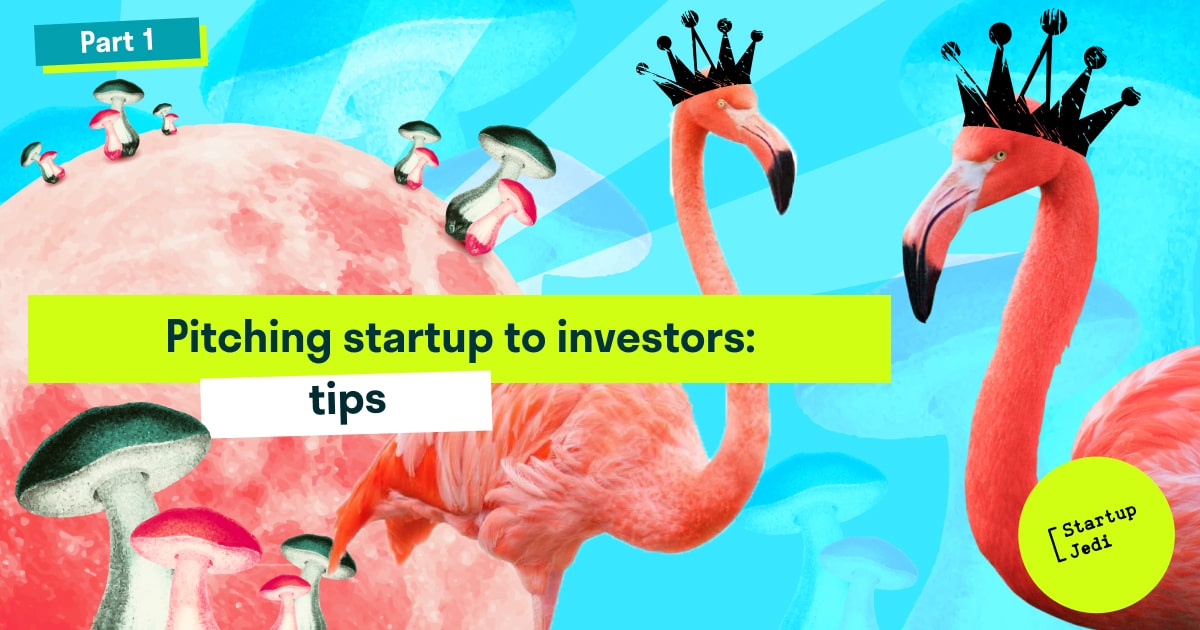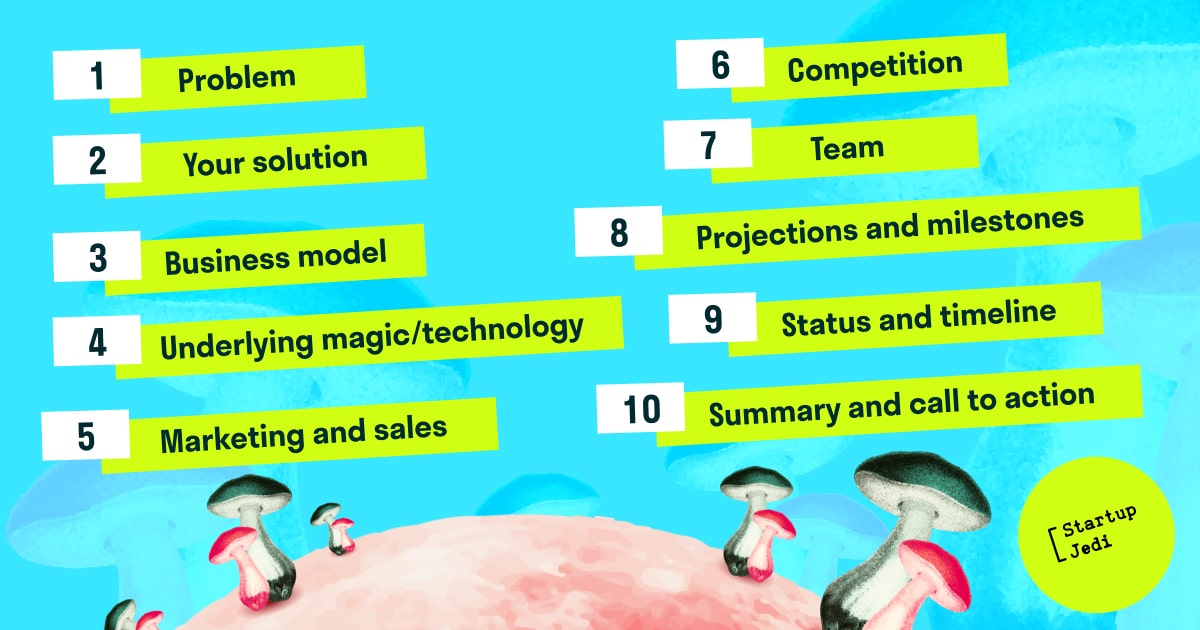
Startup Jedi
We talk to startups and investors, you get the value.

Startup Jedi
We talk to startups and investors, you get the value.
Every founder asks themselves “How to pitch a startup” as soon as the project enters the development stage. Pitch is a must for a startup, unless you and your co-founders are rich and ready to invest your money in your own idea. It is not enough for the creators of an innovative project to have sufficient or even in-depth professional knowledge, to understand the market a little, and to be able to predict trends a little. Presenting your startup is a must-have skill for a founder, especially when the project is in the pre seed or seed rounds.
We have prepared the most detailed article on how to present a startup to investors and in the first part we will tell you in detail about the structure of the pitch deck. Let's go!

Any startup presentation includes pitching — a short speech by the founder where they talk about the product, the market and how all this may be of interest to investors. Pitching includes not only slides that illustrate the founder's theses, but also non-verbal communication — gestures, posture, facial expressions of the speaker, as well as the timbre and tone of speech, the volume of their voice. All of the above together can either help investors get a good impression of the founder and give a future to the project, or, conversely, damage its reputation and, in the long run, lead to the closure of the startup.
The goal of speaking to investors is to raise money for a startup. Pitches take place at Demo Day organized by incubators and accelerators at the end of educational programs for startups. You can also speak to investors at specialized conferences or at personal meetings — for example, after you have sent your presentation by email to a business angel or fund, and your idea seemed interesting.
Let's start with the basics and see what a good presentation looks like.

We all probably remember unsuccessful examples of PowerPoint presentations from school and university, including our own ones. Many people perceive a slide deck as a version of the report and insert text blocks in paragraphs. Looks awful, okay?
Here are three characteristics of good slides:
Minimum text. This means the presentation complements and illustrates what you say in detail, but does not try to replace it in any way. Instead of text, focus on infographics, product visuals and numbers.
Structure. You show not just pictures, but illustrations that help to better understand the essence of the startup and convince the investor that you are selling them a working idea.
Brevity. This applies to both visual and textual information. For example, dedicating one of the slides to a list of benefits is a good idea. But remember, there should be no more than three points in it, so that the attention of the audience is not scattered.
Speaking of how to make a startup presentation, we can mention the theses of Guy Kawasaki, the legendary Apple manager who is considered the father of the concept of evangelism in IT. Kawasaki believes that a pitch should not have more than 10 slides, but each new slide plays a role and reveals a certain aspect. It is important to know what information each of these 10 slides should contain:

Yet, it is not enough to fill out the slides, the structure of a pitch deck is of particular importance. This is what it should look like:
Introduction is where you introduce the product.
Business model slides should contain information on how the project plans to earn and what audience it is targeting, as well as illustrate the marketing strategy.
Investor's motivation to invest in a project, namely why your startup can become a market leader, what it’s competitive advantages are, what predictions help to ensure that the investment will pay off.
Let's have a closer look at each of the structural parts of the pitch.

It is important to mention what the investor is most interested in in the intro part of the pitch deck. Be sure to include a short description of the company, and if your startup is developing software or an application, illustrate the idea with screenshots, so that it is clear how it works. The intro should also answer the question of how the product addresses a certain pain of the consumer.
A convincing startup pitch should contain a description of the technology which the product is based on and metrics — these can be any numbers that illustrate the development of the project, including the number of views over a certain period, the dynamics of customer growth, indicators for coverage.
It is important to place the so-called hero image, or the key image for a startup on the first — or one of the first — slides. This is an illustration that allows the consumer to read as much information about the product as possible, as well as evoke positive emotions in them, motivating them to learn more about the product and the company.
Here you can also place a very short (literally 8-10 words) description of the project, which can also be the slogan of your startup.
In the introductory part, it is worth talking about the characteristics of the product: what it does, how it solves the consumer's pain, and what is special about it in points — X, Y, Z. It will be ideal if you briefly describe the real situation with the consumer problem and show how your product solves it more efficiently and what additional benefits it brings.

The next stage is talking about your business model. Share how you plan to make money on the product and how you make money now, show the sales growth curve.
A good business plan inspires confidence. Listening to you, the investor must understand that this business is what they need.
In this part, you should also talk about market capacity, client portrait, and scaling strategy. Be sure to add screenshots of positive reviews from the first customers — this way the investor will see that there is a demand for the product and users are happy with it.
Do not forget about competitors. Most likely, they have been on the market for several years and occupy a significant segment there. Show their weaknesses to the investor and explain the benefits of the product you are developing.

This part is the culmination of the pitch. If the previous two warmed up the investor, then this should motivate them to make a real decision to invest in a startup.
Be sure to talk about the team and its competencies as for many investors it is this information that matters most, not the metrics and the market. Summarize your project achievements: which competitions you participated in, what results you have achieved, are there any investors or partners.
Add the projections for the monthly growth of the project. When talking about the benefits for the investor, use clear and provable statements based on facts and your startup history.
If you are speaking in front of a large audience and showing a presentation on a screen, keep in mind that your contacts, especially your email, must be readable. If you send the presentation to the investor by email, clearly indicate the subject of the letter.
***
In the second part of the series we will share examples of legendary companies — from Facebook to Uber — and analyze their pitch decks.
Facebook: facebook.com/StartupJedi/
Telegram: t.me/Startup_Jedi
Twitter: twitter.com/startup_jedi
Comments